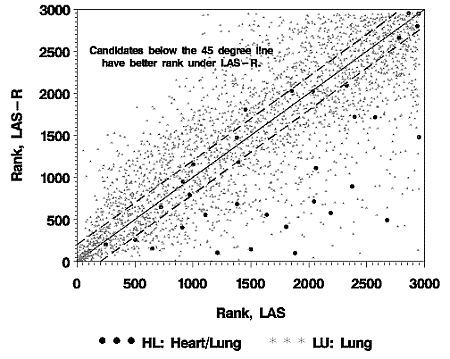Impact of the Revised Lung Allocation Score on Heart-Lung Candidates
Scientific Registry of Transplant Recipients, Minneapolis Medical Research Foundation, Minneapolis, MN
University of Minnesota, Minneapolis, MN
Meeting: 2013 American Transplant Congress
Abstract number: 244
Introduction: The lung allocation score (LAS) has been used since 2005 to rank US lung transplant candidates for access to transplant. A revised LAS (LAS-R) system that will better predict outcomes for the current cohort of transplant candidates has been approved and awaits implementation. Heart-lung (HL) candidates are not included in the modeling that produced LAS or LAS-R, yet they receive a score as determined by these systems. We studied: (1) whether LAS-R improves the relative ranking of HL candidates; and (2) whether using HL candidacy as a separate variable improves relative ranking of HL candidates.
Methods: Using SRTR standard analysis files, we computed LAS and LAS-R for 34 HL candidates and a comparison group of 2920 lung-only (LU) candidates listed in 2011. We compared HL candidate scores and ranks under LAS and LAS-R (figure). We then modeled LAS-R using HL candidacy as a separate variable.
Results: Mean LAS for HL candidates was 36 (range: 30-63); mean LAS-R was 42 (range: 28-65, P=0.0001). By comparison, mean LAS and LAS-R for LU candidates were each 39. For 79% (27/34) of HL candidates, LAS was higher (i.e., lower numerical rank on the waiting list) under the LAS-R. Although some HL candidate rankings improved greatly under LAS-R, none were ultimately 0-100, and 15% were 100-200. The addition of HL candidacy to the LAS-R waiting list and posttransplant survival models did not improve mortality prediction. Adjusted hazard ratios for HL candidacy were 0.60 (95% CI: 0.30-1.2) for wait-list mortality and 1.08 (95% CI: 0.61-1.91) for posttransplant mortality.

Conclusions:1) The LAS-R may improve HL candidate ranks on the LU waiting list, but not to a degree that materially impacts likelihood of transplant. In addition, despite LAS-R increases, in practice it may minimally affect access to HL blocks due to current policy, which usually prioritizes HL candidates based on heart urgency. 2) Addition of HL candidacy to the LAS-R models did not improve mortality prediction.
To cite this abstract in AMA style:
Skeans M, Heubner B, Hertz M, Israni A, Valapour M. Impact of the Revised Lung Allocation Score on Heart-Lung Candidates [abstract]. Am J Transplant. 2013; 13 (suppl 5). https://atcmeetingabstracts.com/abstract/impact-of-the-revised-lung-allocation-score-on-heart-lung-candidates/. Accessed December 27, 2025.« Back to 2013 American Transplant Congress
